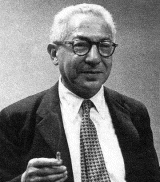Isidor Isaac Rabi

Nuclear Magnetic Resonance
Nobel Prize Physics 1944
Nobel Prize Physics 1944
Rabi was born in the town of
Rymanow
, in what is now Poland, in 1898 with the name Israel Issac Rabi.
His parents immigrated to New York and during the public school enrollment,
a school official mistakenly wrote down his name as Isidor, not Israel ,
which is how Rabi received the distinction of being renamed by the New York public school system. Rabi kept the name.
Rabi entered Cornell University in 1916 with the intention of becoming an engineer,
but after taking a chemistry course in qualitative analysis, he switched to chemistry,
in which he graduated in 1919. Unable to find steady work, he returned to Cornell in
1922 as a graduate student and then to Columbia in 1923 after having failed to receive a fellowship at Cornell.
At Cornell, he found he had taken all the available chemistry courses, so he enrolled in physics, where he made perhaps his first scientific discovery:
"I soon realized that the part of chemistry I liked was called physics. If someone had pointed that out to me before, it would have saved me many, many years."
In 1927, Rabi decided he must go to Europe to hopefully work for Schrödinger, but ultimately, ended up working for
Otto Stern
. Stern was famous, because he and Walter Gerlach had in 1922 performed one of the truly classic experiments of physics -- the
Stern Gerlach experiment
, whose result was ultimately interpreted as showing the electron has an intrinsic angular momentum, or spin.
The time spent with Stern was useful. Originally, Rabi had only wanted to do theoretical work, but Stern forced
him to learn something about molecular beam experiments, and it was this knowledge that he later used to
develop his method of
Nuclear Magnetic Resonance
, for which he received the Nobel Prize. His resonance method was developed only as a method to measure the magnetic moment
of the nucleus of the atom, which was an open problem for most nuclei in those days. However, the technique turned out to
have widespread applications to both chemistry and medicine, and is an example of how pure research can have great practical applications.
On the Importance of Basic Research
Perhaps to some it would seem silly to write anything on the necessity of basic research.
Is not the importance of such research obvious?
Maybe not. I offer the scientific debacle that was the closing of basic research at Bell Labs (Bell Labs Kills
Fundamental Physics Research) to argue it is not.
Historically, innovation has flourished in the fertile environment that is
provided by basic research. Research into ideas that do not immediately have any
obvious applications often unexpectedly yield tremendous applications.
Consider the ubiquitous GPS system that is responsible for your car's navigation system. It is in fact
the result of basic research. In other words, research that was done simply because it was interesting to think about, and
not because of any potential applications.
So, the GPS system depends on the precision of atomic clocks, which
relies on the hydrogen maser which in turn was dependent upon basic research into
optical pumping. More fundamentally, GPS
relies on Einstein's theory of
general
relativity, which perhaps
is the ultimate example of pure research without regard to any possible applications.
GPS is comprised of 24 satellites orbiting the earth, all of
which must have synchronized atomic clocks. Determining
your position on the
earth requires the use of 4 of the satellites-- 3 for your longitude, latitude,
and altitude, and the fourth to verify the accuracy of the clock in your GPS unit.
Since clocks run at different rates depending on the strength of the gravitational
field they are in -- and since gravity varies with satellite height -- general relativity
must be used.
But wait, as they say, there is even more fundamental research
present in the GPS system. The whole idea of stimulated emission, on which masers
and lasers depend, was discovered by Einstein in 1916. The 1916 paper, "Emission
and Absorption of Radiation in Quantum Theory" (Zur Quantentheorie der Strahlung),
like all of Einstein's research, was basic research.
 Cogitations on Physics, Math, and Computers
Cogitations on Physics, Math, and Computers